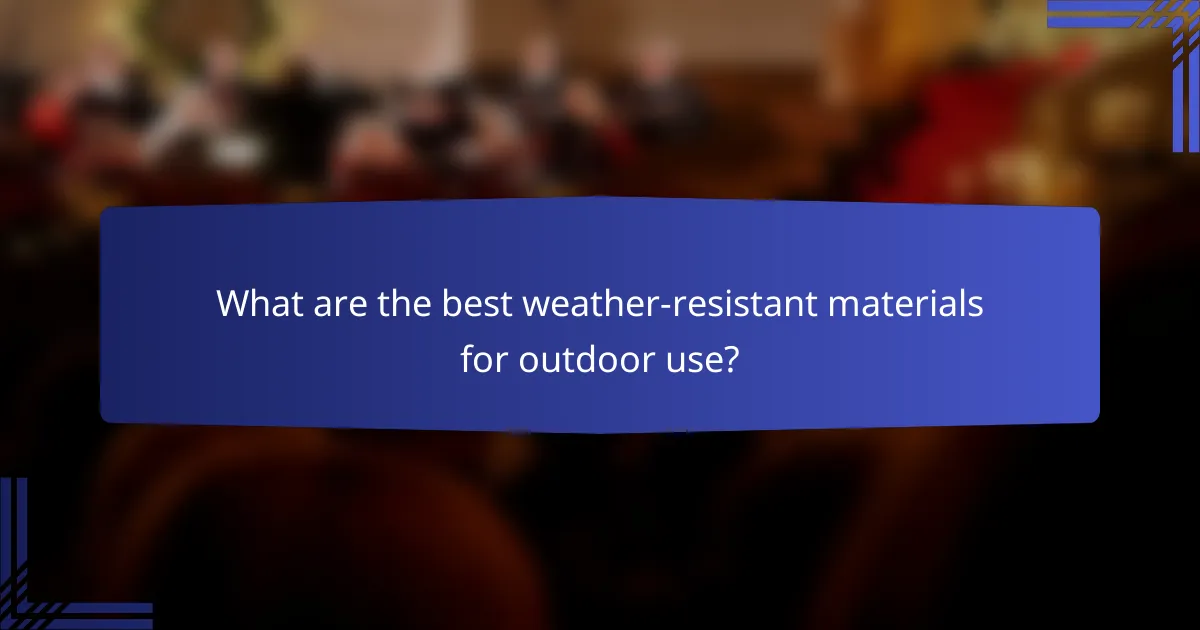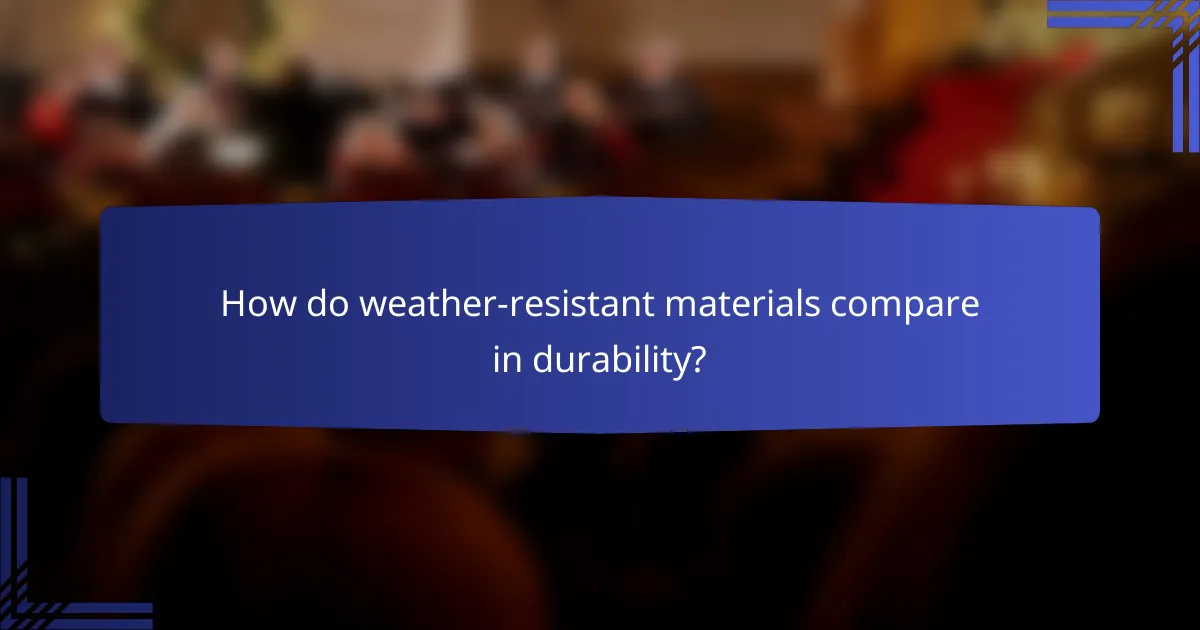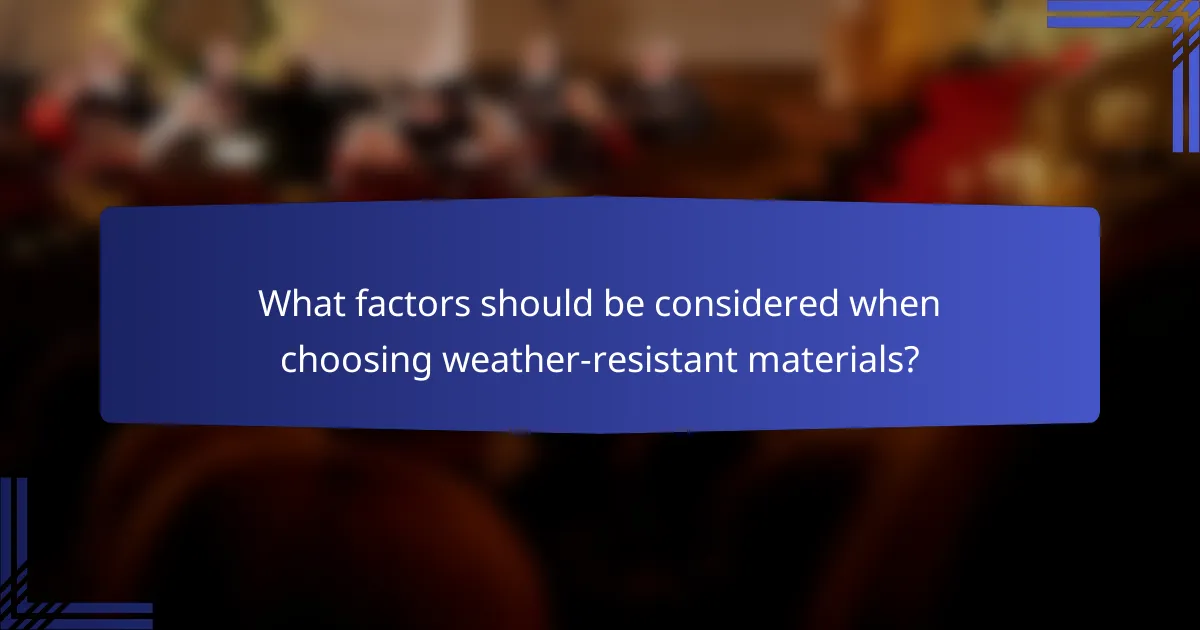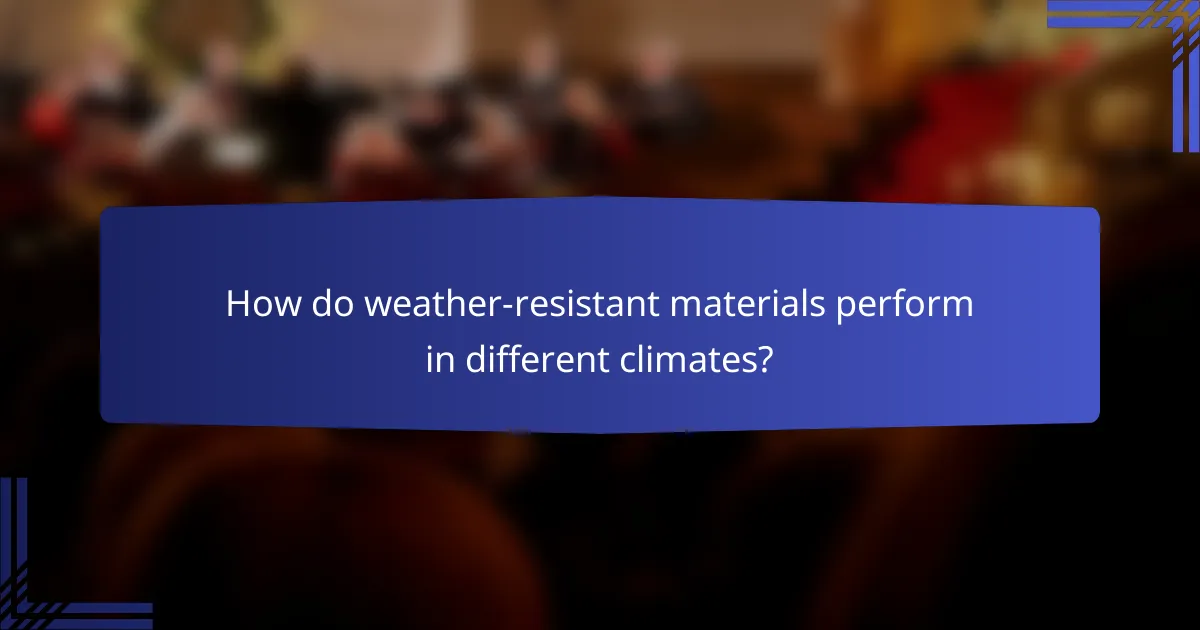Weather-resistant materials are essential for outdoor applications, offering durability and low maintenance while withstanding harsh environmental conditions. Common options include polycarbonate panels, fiberglass composites, and stainless steel, each designed to endure moisture, UV radiation, and temperature fluctuations. Regular maintenance is crucial to maximize their lifespan and performance, ensuring they remain effective over time.

What are the best weather-resistant materials for outdoor use?
The best weather-resistant materials for outdoor use include polycarbonate panels, fiberglass composites, stainless steel, vinyl siding, and concrete. These materials are chosen for their durability, low maintenance needs, and ability to withstand various environmental conditions.
Polycarbonate panels
Polycarbonate panels are lightweight yet incredibly strong, making them ideal for outdoor applications such as greenhouses and patio covers. They can withstand extreme temperatures and resist UV radiation, which helps prevent yellowing and degradation over time.
When selecting polycarbonate panels, consider options with UV protection and multi-wall designs for better insulation. Regular cleaning is essential to maintain clarity and performance.
Fiberglass composites
Fiberglass composites are known for their high strength-to-weight ratio and resistance to corrosion, making them suitable for outdoor furniture and structural components. They can mimic the appearance of wood while offering superior durability.
These materials require minimal maintenance, but it’s advisable to check for surface wear and clean them periodically to prolong their lifespan. Look for products that are specifically designed for outdoor use to ensure optimal performance.
Stainless steel
Stainless steel is a popular choice for outdoor fixtures and furniture due to its resistance to rust and corrosion. It is durable and can withstand harsh weather conditions, making it ideal for coastal areas where salt exposure is a concern.
To maintain stainless steel, regular cleaning with mild soap and water is recommended. Avoid abrasive cleaners that can scratch the surface. Choosing higher grades of stainless steel can enhance longevity in outdoor environments.
Vinyl siding
Vinyl siding is a widely used material for exterior walls because of its weather resistance and low maintenance requirements. It does not require painting and can withstand harsh weather, making it a cost-effective choice for homeowners.
When installing vinyl siding, ensure proper ventilation and insulation to prevent moisture buildup. Regular inspections for damage or fading can help maintain its appearance and functionality.
Concrete
Concrete is one of the most durable materials for outdoor use, suitable for patios, walkways, and foundations. It can withstand extreme weather conditions and is resistant to rot and pests.
To enhance its weather resistance, consider using sealants to protect against moisture and staining. Regular maintenance, such as cleaning and resealing, can significantly extend the life of concrete surfaces.

How do weather-resistant materials compare in durability?
Weather-resistant materials vary significantly in durability, influenced by their composition and intended use. Generally, these materials are designed to withstand environmental stressors like moisture, UV radiation, and temperature fluctuations, ensuring longevity and performance.
Polycarbonate vs. fiberglass
Polycarbonate and fiberglass are both popular weather-resistant materials, but they have distinct durability characteristics. Polycarbonate is known for its high impact resistance and flexibility, making it suitable for applications like roofing and glazing. In contrast, fiberglass offers excellent strength and rigidity, often used in boat construction and outdoor furniture.
When comparing the two, consider that polycarbonate can withstand extreme temperature changes without cracking, while fiberglass may require more maintenance to prevent degradation from UV exposure. For projects requiring transparency and lightweight properties, polycarbonate is typically preferred, whereas fiberglass is favored for structural applications.
Stainless steel vs. vinyl
Stainless steel and vinyl are both durable options for outdoor applications, but they serve different purposes. Stainless steel is highly resistant to corrosion and rust, making it ideal for hardware, railings, and fixtures exposed to harsh weather. Vinyl, on the other hand, is lightweight and resistant to fading, often used in siding and fencing.
While stainless steel can last for decades with minimal maintenance, it may be more expensive upfront compared to vinyl. Vinyl can be a cost-effective choice but may require replacement after several years due to wear and tear. When choosing between them, consider the specific environmental conditions and aesthetic preferences.
Concrete longevity
Concrete is one of the most durable weather-resistant materials available, often lasting several decades when properly maintained. Its resistance to moisture and temperature fluctuations makes it suitable for foundations, driveways, and outdoor structures. However, the longevity of concrete can be affected by factors such as quality of mix, installation techniques, and exposure to de-icing salts.
To enhance the lifespan of concrete, consider applying sealants to protect against water infiltration and freeze-thaw cycles. Regular maintenance, including cleaning and repairing cracks, can significantly extend its durability. Overall, investing in high-quality concrete and proper care can yield a long-lasting, weather-resistant solution.

What maintenance is required for weather-resistant materials?
Weather-resistant materials require regular maintenance to ensure their durability and performance. This includes cleaning, applying protective coatings, and addressing any repairs promptly to extend their lifespan.
Cleaning procedures
Regular cleaning is essential for maintaining the effectiveness of weather-resistant materials. Use mild detergents and soft brushes to remove dirt and debris without damaging the surface. For more stubborn stains, consider using a pressure washer set to a low setting, ensuring you keep the nozzle at a safe distance.
Frequency of cleaning can vary based on environmental conditions; typically, a thorough clean every few months is advisable, especially in areas with high pollution or salt exposure.
Protective coatings
Applying protective coatings can significantly enhance the longevity of weather-resistant materials. These coatings act as a barrier against moisture, UV rays, and other environmental factors. Depending on the material, you may need to reapply these coatings every one to three years.
Choose coatings specifically designed for the material type, such as sealants for wood or specialized paints for metal. Always follow the manufacturer’s instructions for application and drying times to achieve the best results.
Repair techniques
Prompt repairs are crucial for maintaining the integrity of weather-resistant materials. For minor damages, such as scratches or small cracks, use appropriate fillers or sealants to restore the surface. For larger issues, such as significant structural damage, replacement of the affected section may be necessary.
Regularly inspect materials for signs of wear or damage, especially after severe weather events. Addressing repairs quickly can prevent further deterioration and costly replacements down the line.

What are the costs associated with weather-resistant materials?
The costs associated with weather-resistant materials include initial purchase prices, installation expenses, and potential long-term savings. Understanding these factors can help in making informed decisions about investments in durable materials.
Initial purchase prices
Initial purchase prices for weather-resistant materials can vary widely based on the type and quality. For instance, high-quality vinyl siding may range from $2 to $7 per square foot, while premium materials like fiber cement can cost between $5 and $10 per square foot. It’s essential to consider the balance between upfront costs and expected longevity.
When selecting materials, also factor in the specific climate conditions of your area, as this can influence the durability and effectiveness of the materials chosen. Investing in higher-quality options may lead to better performance and fewer replacements over time.
Long-term savings
Long-term savings from weather-resistant materials often stem from reduced maintenance and replacement costs. For example, materials like metal roofing can last up to 50 years, significantly lowering the need for repairs compared to traditional asphalt shingles, which may last around 20 years.
Additionally, energy-efficient weather-resistant materials can lead to lower utility bills. Insulated siding or reflective roofing can help maintain indoor temperatures, potentially reducing heating and cooling costs by 10-20% over time.
Installation costs
Installation costs for weather-resistant materials can vary based on complexity and local labor rates. On average, homeowners may expect to pay between $1 and $3 per square foot for installation, depending on the material and the contractor’s expertise. It’s advisable to obtain multiple quotes to ensure competitive pricing.
Keep in mind that proper installation is crucial for maximizing the lifespan of weather-resistant materials. Hiring experienced professionals can prevent costly mistakes and ensure that warranties remain valid, so consider this when budgeting for your project.

What factors should be considered when choosing weather-resistant materials?
When selecting weather-resistant materials, consider climate conditions, material compatibility, and your project budget. Each factor plays a crucial role in ensuring durability and longevity in various environmental settings.
Climate conditions
Climate conditions significantly influence the choice of weather-resistant materials. For instance, areas with high humidity may require materials that resist mold and corrosion, while regions with extreme temperatures might need materials that can withstand thermal expansion and contraction.
Evaluate local weather patterns, including rainfall, snowfall, temperature fluctuations, and UV exposure. This assessment will guide you in selecting materials that can endure specific environmental stresses, such as heavy rain or intense sunlight.
Material compatibility
Material compatibility is essential for ensuring that different components of a project work well together. For example, using incompatible materials can lead to issues like corrosion or structural failure over time.
Consider how materials interact with one another, especially in terms of expansion, contraction, and chemical reactions. It’s advisable to consult manufacturer guidelines or industry standards to ensure that chosen materials are suitable for your specific application.
Project budget
Your project budget will ultimately determine the quality and type of weather-resistant materials you can afford. While it may be tempting to choose cheaper options, investing in high-quality materials can save money in the long run by reducing maintenance and replacement costs.
Establish a budget range early in the planning process and prioritize materials that offer the best balance of durability and cost-effectiveness. Be aware of potential hidden costs, such as installation or maintenance, which can impact your overall budget.

How do weather-resistant materials perform in different climates?
Weather-resistant materials are designed to withstand various climatic conditions, including extreme temperatures, humidity, and precipitation. Their performance varies significantly based on the specific climate, influencing durability, maintenance needs, and overall cost.
Durability in Hot Climates
In hot climates, weather-resistant materials must endure high temperatures and intense sunlight. Materials like UV-resistant plastics and metals with protective coatings are ideal as they resist fading and degradation. Regular inspections can help identify wear and tear before it leads to significant damage.
Choosing lighter colors can also reduce heat absorption, prolonging the lifespan of materials. For instance, reflective roofing materials can help maintain lower temperatures in buildings, enhancing durability and energy efficiency.
Durability in Cold Climates
Cold climates present challenges such as freezing temperatures and snow accumulation. Weather-resistant materials should be able to withstand freeze-thaw cycles without cracking. Options like treated wood or composite materials are effective as they resist moisture absorption and subsequent freezing damage.
It’s crucial to ensure proper drainage systems are in place to prevent water buildup, which can lead to ice formation and structural issues. Regular maintenance, such as clearing snow and ice, is essential for preserving the integrity of these materials.
Durability in Humid Climates
In humid climates, materials must resist mold, mildew, and corrosion. Weather-resistant options like stainless steel, fiberglass, and specially treated woods are recommended due to their moisture resistance. Ventilation is also important to reduce humidity levels and prevent material degradation.
Applying protective sealants can enhance the longevity of materials exposed to high humidity. Regular cleaning and maintenance can help mitigate mold growth, ensuring that the materials remain functional and visually appealing.
Cost Considerations
The cost of weather-resistant materials varies based on climate and material choice. In general, investing in higher-quality materials may lead to lower long-term maintenance costs and increased durability. For example, while treated wood may have a higher upfront cost, its longevity in humid conditions can offset initial expenses.
It’s important to consider not just the purchase price but also the potential savings from reduced maintenance and replacement needs. Budgeting for regular upkeep is essential to maximize the lifespan of weather-resistant materials in any climate.
